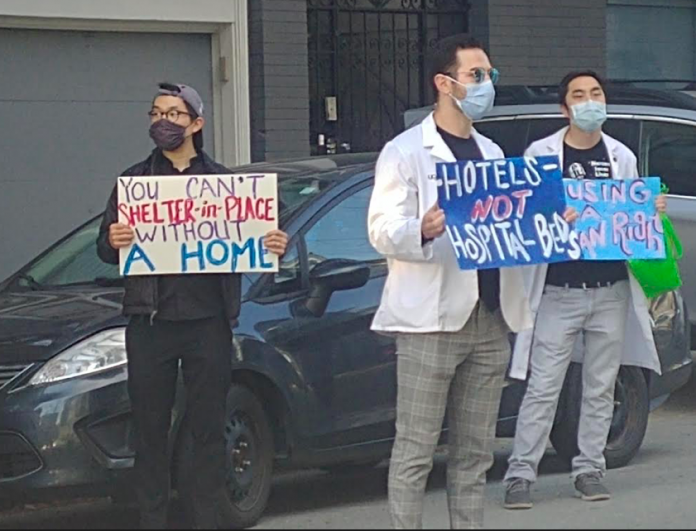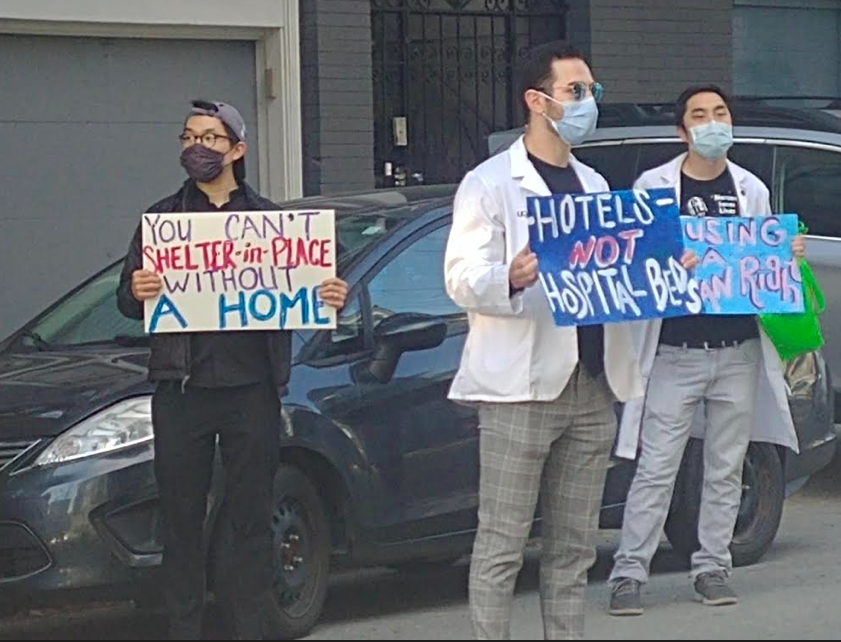
Take some salacious information, add a single person with a point of view, and suddenly you have a major international story – that can do serious damage to a whole lot of people.
That happens all too often in journalism, and we had a classic case this week, when KTVU “broke” the “news” that San Francisco officials are providing alcohol and drugs to homeless addicts living in hotel rooms.

This is neither a scandal nor a scoop: The city has never hidden the fact that emergency shelter-in-place includes medical harm-reduction. Seattle has been doing this longer than SF. Other Bay Area counties are doing it too.
Exactly 11 people, out of the hundreds of at-risk folks quarantined in hotel rooms, have been given small amounts of alcohol to avoid withdrawal symptoms (and to keep them from leaving to buy their own).
The “drugs” that are provided are nicotine (seriously, do you want people to cold-turkey quit a hugely addictive substance while confined to a hotel room?) cannabis (which is, for many, medicine) and methadone, which is a medical treatment for heroin addiction.
Nobody at City Hall is handing crack or heroin to people in the hotel rooms.
There is, honestly, nothing here, folks. This is not news.
But after one person – exactly one person – complained about it on Twitter, a very rational, small-scale program became a sensation.
Help us save local journalism!
Every tax-deductible donation helps us grow to cover the issues that mean the most to our community. Become a 48 Hills Hero and support the only daily progressive news source in the Bay Area.
It made The Daily Mail in the UK. It made The New York Post. It’s going to be a hot topic on Fox News.
And to my surprise (although I shouldn’t be surprised), it was a front-page story in the SF Chronicle.
All of this because Tom Wolf, who works as a substance-abuse counselor for the Salvation Army, said he disagreed with the policy.
Let’s look at the headlines:
San Francisco gives free drugs, alcohol to homeless quarantining in hotels (NY Post)
Debate ensues over San Francisco providing alcohol, drugs to homeless in hotels (KTVU)
San Francisco faces backlash as it delivers alcohol, tobacco and medical marijuana to homeless addicts (Daily Mail).
There will be more. And the rightwingosphere will put pressure on the White House to cut off FEMA funding that pays for hotels for at-risk homeless people. That could cost lives.
I’m sorry, but this is just irresponsible journalism.
There is no serious “debate” here. There is no credible “backlash” (except that created by the right-wing media).
There is one person on Twitter.
I don’t know Tom Wolf. I do know that he is dedicating his life to helping people recover from substance abuse, which is wonderful and important.
He is not a supporter of the city’s harm-reduction strategy, and that’s his right. Here’s what he told me tonight:
I am not against harm reduction in its entirety. But The only drugs being “administered” are the Methadone and Suboxone. They are/were delivering bottles of booze and weed and cigarettes. And what nobody talks about is the fact that even those COVID19 + can still leave the hotel for 30 minutes for “essential services”. Just long enough to score a bottle or some dope. So really what they’re doing is letting these people struggling with addiction double down on their drug/alcohol supply. That to me is enabling. That’s way different than harm reduction
But I think it’s safe to say that the vast majority of medical professionals in San Francisco disagree with him. His position is way, way, in the minority; doctors and public-health experts who are trying to keep people alive in this crisis are almost entirely unified in support of what cities like SF are doing.
Presenting one small Twitter discussion (there wasn’t even much “debate” that “ensued”) and suggesting that a single viewpoint from one person is valid reason for reporters to make a huge fuss about a total non-story is just wrong.
While we’re at it: The Phil Matier story about homeless people coming from all over for a free hotel room (and now, I guess, for free booze) was another bizarre example of inaccurate non-news:
“People are coming from all over place — Sacramento, Lake County, Bakersfield,” Fire Chief Jeanine Nicholson said. “We have also heard that people are getting released from jail in other counties and being told to go to San Francisco, where you will get a tent and then you will get housing.”
As an example, Nicholson said that up to 75% of the estimated 100 campers living in tents along the Fulton Street side of the Asian Art Museum appear to have come to the city with the hope of getting a hotel room.
Matier quotes exactly one named source – the fire chief, who works for the mayor, who is trying to promote the idea that if we put homeless people in safe hotel rooms, they will come from all over.
Joe Eskenazi at Mission Local quotes half a dozen front-line workers who say that the Chronicle/Breed story is a myth:
“The Haight is always the place young people come to, but now it’s not the case,” says Howe. “I have not met one person who has come to town in the last two months.”
Adds Felanie Castro, a case manager at GLIDE, “They’re coming for hotel rooms? The folks who are already here hoping to get hotel rooms are not getting hotel rooms.”
“I have meals, water, masks, sanitizer, Narcan, hygiene supplies, and tents. I see 100 to 200 people a day. And I have not seen an influx of people. I have seen a redistribution of people who were already outside.”
Homeless front-line worker Shannon Ducharme, who was herself homeless in San Francisco a few years back, says she has, thus far, met one couple from Reno who came to this city in hopes of scoring a hotel room. And that’s it.
As for the Asian Art Museum encampment the fire chief claimed was 75 percent out-of-towners, “that’s completely untrue,” says Ducharme. “I have been working with all of the guys who are there for four or five years. Some of them I’ve known for 10 years, since before I’ve been working with them.”
Does that mean people aren’t heading to San Francisco to see what they can get? No. Again, that could be happening. But nobody has come close to proving it, beyond anecdotes. And, if it is happening, it’s news to the people on the street working hand-in-hand with our vulnerable homeless.
Everyone’s looking for hot stories right now, and I get that. But as The New York Times tells its staff: “Get it first. But first get it right.”

